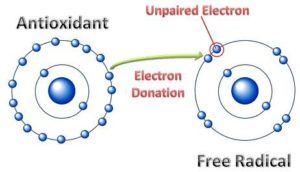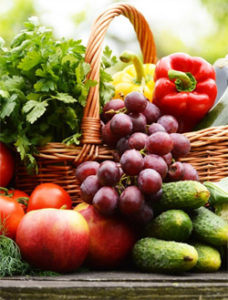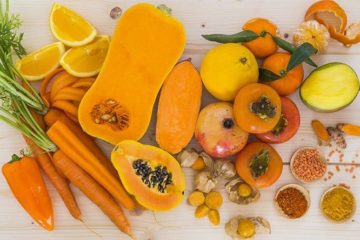Antioxidants are one of the best reasons to eat more plant foods. If everyone knew what powers they had, the Health Department would never need to encourage us to eat two pieces of fruit a day and five serves of vegetables – we’d eat WAY more than that without anyone saying anything!
So what are antioxidants, and what do they do? Read on and find out.
The chemical factory
Our bodies are big, complicated chemical factories. All-day long, every minute, chemical reactions are occurring. Molecules from food, air and our own body parts are breaking down into atoms, and those atoms are recombining with other atoms, then connecting to form entirely new substances needed to run the ‘factory’ and make our bodies function at all levels.
All this breaking down and recombining of atoms is like a giant, continual game of musical chairs. Describing this giant game of ‘musical chairs’ going on inside our bodies is what biochemistry is. It’s about the predictable patterns of how these compounds break down and reassemble themselves.
In order to understand why we need antioxidants in large quantities, we need to understand a little about these processes.
Atomic chaos in our bodies
Here’s an explanation in a nutshell:
Atoms are a nucleus surrounded by moving electrons. The atoms in the human body ‘want’ to have a set number of electrons in their outer shells. Oxygen, nitrogen and carbon need to have 8 electrons, and hydrogen needs to have 2 electrons – then they can be called ‘stable atoms’.
A ‘stable atom’ is ‘content’ and causes no damage to things around it.
If one of these atoms is left with anything less than 8 electrons in its outer shell (2 for hydrogen) – or ‘can’t find a chair’ as in the musical chairs game, it will ‘go crazy’ trying to join up with another atom, to try and make up the difference. Such an atom, with the wrong number of electrons, is called ‘unstable’.
An unstable atom has a special name – it is called a ‘free radical’ which well describes its life of chaos and destruction.
Ideally, an atom with a shortage of electrons, a free radical, will combine with another unstable atom, and all will be well; together they become ‘stable’. If they cannot find such a partner, they are like a child at the party who, upon finding they have no chair in the game, does not retire to the edge to watch, but throws a tantrum. In the same way, havoc reigns in the body until the free radical atom finds a suitable partner.
This havoc takes the form of stealing electrons from atoms in the walls of surrounding organs until it becomes ‘stable’. This damages the cell at all levels, which eventually shows up as disease. If the DNA is the part that gets damaged, the cell is set up for a mutation, the first step of cancer.
The unstable atom may now be stable – but at the expense of the health of the surrounding organ.
The antioxidant heroes
Only anti-oxidants can prevent and mend this damage at the cellular level.
When an atom loses electrons, and is left without a ‘partner’ atom supplying the lost number of electrons, it is said to be ‘oxidised‘. Think of it like rust, which is oxidised metal.
An ANTIoxidant is a compound that contains atoms with extra electrons in their outer shells which are then shared with those unstable atoms it finds in the body. You can watch this short 1-minute animated video on how this happens <here>. (Note: you don’t need the advertised product – see below how to get antioxidants cheaply and easily.)
Oxygen, carbon and nitrogen end up then with 8 electrons in their outer shell, and hydrogen – 2 electrons.
This causes those unstable atoms to become stable and ‘settle down’, find their place and do their jobs in the body.
This translates to minimal or no damage to surrounding body organs. This is the basis of health – from the cell level up.
Where do we get antioxidants?
Antioxidants come from plants which we eat. Meat, dairy products, and eggs contain some antioxidants, which came originally from the nutrient-rich plants the animals fed on. But we get a lot more eating the plants directly.
Antioxidant rich foods are –
- fruit
- vegetables
- legumes
- tubers
- nuts
- seeds and
- whole grains.
Refined plant foods like sugar and white flour are depleted of anti-oxidants.
From this it should seem clear that the more plant foods we eat, the healthier we will be and the less illness we should have. On the other hand, the more animal foods we eat, the more chance there is for damage to body organs, resulting in ill health.
This is, in fact, what the science shows, and antioxidants are a major reason why this is so.
While this antioxidant story is not the entire story of health, it is a vitally important part of it; we limit vegetable intake to our own demise.
The best sources of antioxidants
We can tell which plants have the highest levels of antioxidants by looking at their colours.
The general rule is that the brighter or darker the colour, the more antioxidants it has.
More free radicals are made stable by
- red grapes than green, by
- yellow corn than white, by
- red cabbage than white cabbage, by
- blackberries than by white mulberries.
The pigment, or colour, IS the anti-oxidant.
Berries have some of the highest anti-oxidant levels in the plant kingdom. Comparing 100 sorts of berries for anti-oxidant levels places crowberries and dog-roseberries first.
I’ve never seen those berries before, but of the berries more commonly available, the awards go to
- blackberries, then
- cranberries,
- raspberries,
- blueberries and
- strawberries in that order.
Even dried berries such as dried cranberries and currants pack in a lot of antioxidants. So do pomegranates. IN fact, pomegranate juice has even more antioxidants than red wine, grape juice, green tea and acai juice.
Berries and pomegranates not only help prevent DNA damage but go further to stimulate the body’s own antioxidant enzymes. That means they multiply the antioxidants, so there are more than the body started with.
Even more concentrated sources of antioxidants are herbs and spices, particularly turmeric.
Other things antioxidants do
Here are a few of the discovered benefits of anti-oxidants.
- Reduce blood pressure and inflammation in arteries, and therefore protects against heart attacks.
- Protect against urinary tract infections. (antioxidants in cranberry juice)
- Stop gout pain fast (antioxidants from cherries)
- Anti-oxidants from all foods can prevent, slow and often reverse tumour growth by preventing and reversing DNA damage from free radicals. Synthetic antioxidants from supplements, however, have been found in some cases to actually promote tumour growth. Food is always the safest option.
- some antioxidants protect against UV light and therefore, sunburn (antioxidants in green leafy vegetables like spinach and kale). Read more about how this works <here>.
- Reduce muscle soreness in endurance runners and weight lifters (studies show cherries and blueberries are the best at this). But all antioxidant-rich foods do this – and this is one of the most noticeable things athletes notice upon adopting a plant-rich diet.
- lower the risk of diabetes and
- depression
- improve asthma
- reduce incidences of gastric reflux and Barrett’s oesophagus and
- Can you believe this? Antioxidants have been found to raise sperm counts.
Such is the power of antioxidants to protect our bodies from self-destruction.
How many do I need?
If you have one of the conditions listed above, you can concentrate on the particular antioxidant-rich foods listed to help your condition. Find out the therapeutic dose used in the studies and take that. (Please note that some drug-managed conditions preclude dosing up on certain antioxidants, so if you are on a drug and not sure, get advice from a qualified nutritionist.)
You can also work at meeting the Australian dietary guidelines of –
- Eating at least 5 serves of vegetables every day. A serve is 1⁄2 cup cooked vegetables (hot chips don’t count!) or 1 cup of salad.
- Eating at least 2 serves of fruit every day. A serve is 1 medium piece or 2 small pieces of fresh fruit, or one cup of chopped or canned fruit (no added sugar).
Don’t disparage these simple guidelines. If everyone in our country or the whole world achieved these minimal amounts, chronic disease rates would plummet. Because all of these foods are filled with antioxidants and other active phytochemicals.







0 Comments